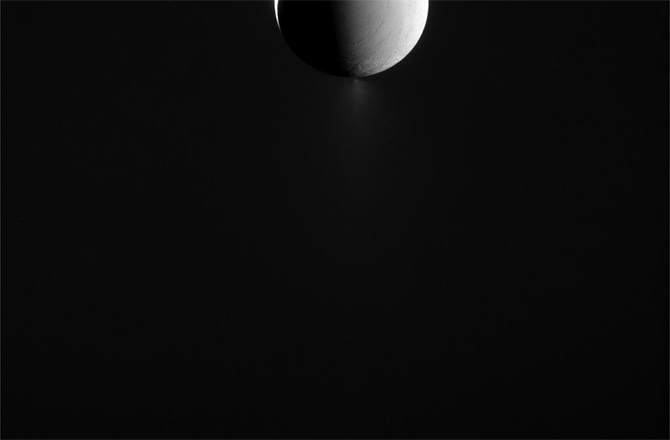Cassini Watches Enceladus Fizz Into Space

NASA's Cassini mission is no stranger to the mysterious Saturn moon Enceladus — the icy world contains a sub-surface ocean and, through vast chasms etched through the moon's south pole, powerful geysers blast water vapor into space.
In this slightly deceptive photo of Enceladus, captured by Cassini on May 10, the extent of the water vapor plume becomes obvious. But why is it deceptive?
ANALYSIS: Enceladus Has Potentially Life-Giving Hydrothermal Activity
The right of the 313-miles (504-kilometer) wide moon appears to be sunlit, but that is not the case. Instead, the illumination is being created by reflected sunlight bouncing off Saturn's cloudy atmosphere. To the left, only a very slight crescent of bright sunlight can be seen illuminating the far side of Enceladus. [See more amazing photos of Enceladus]
In its ongoing efforts to understand the nature of Enceladus' plumes fizzing into space, the water vapor is best observed when it is back-lit and Cassini is viewing Enceladus from its night-side.
It is thought that tidal interactions with the gas giant create a dynamo of sorts inside Enceladus' core, maintaining its ocean in a liquid state. The water is heated at the core and forced through fissures in the moon's south polar "Tiger Stripes" that are known to be the sources of the geysers. Since arriving in Saturn orbit over a decade ago, Cassini has been characterizing this fascinating region on the icy surface.
ANALYSIS: Enceladus Spreads Ghostly Ice Tendrils Around Saturn
Breaking space news, the latest updates on rocket launches, skywatching events and more!
Both Enceladus and larger Jovian moon cousin Europa are known to contain sub-surface oceans protected beneath an icy crust. Astrobiologists are also hopeful that other moons of the gas giants may also contain such oceans, where basic forms of life may be able to thrive if they have access to heat, liquid water, nutrients and oxygen.
But the best is yet to come.
Sadly, Cassini is fast approaching the "Grand Finale" stage of its mission where it will be commanded to sweep out of Saturn's ring plane and race through gaps in the rings. Should it survive this daring maneuver, by 2017, mission managers will start to plan its fiery end by crashing into Saturn's atmosphere. But before that, Cassini will make 3 more passes of Enceladus on Oct. 14 (over the north pole), Oct. 28 (through the moon's water vapor plumes), and one more time on Dec. 19 (over the south pole).
For more information about how this photograph was captured, read the NASA news release.
This article was provided by Discovery News.
Ian O'Neill is a media relations specialist at NASA's Jet Propulsion Laboratory (JPL) in Southern California. Prior to joining JPL, he served as editor for the Astronomical Society of the Pacific‘s Mercury magazine and Mercury Online and contributed articles to a number of other publications, including Space.com, Space.com, Live Science, HISTORY.com, Scientific American. Ian holds a Ph.D in solar physics and a master's degree in planetary and space physics.

